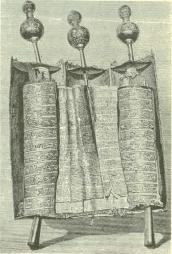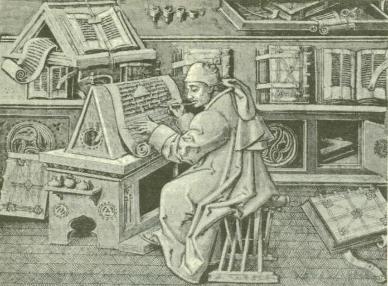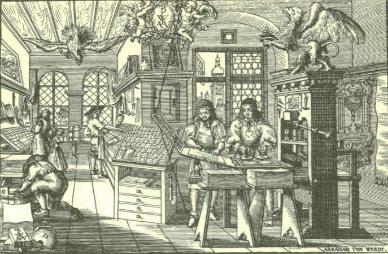About the history of books from ancient times to modern leather bound books.
Books in modern general usage, are printed volumes, usually bound, containing a literary work, historical or other records, statistical, mathematical, or other data, pictorial representations, musical scores, or combinations of a number of these elements, The term is also applied to the major sections of the old testament, as the first book of Moses (Genesis), and to the major divisions of a literary work, as "the six books" of the Aeneid by Virgil. By extension it applies to volumes containing blank pages or prepared forms for keeping records. Books containing maps and geographical data are called atlases and gazetteers.
Books as historical records; as means for expression of thought and feeling, either directly or in the form of imaginative writing; and as mediums for the deposit and dissemination of knowledge, have both reflected and tremendously influenced the development of civilization. Some scholars consider as the earliest books the graven clay and stone tablets and polygonal cylinders of the ancient Assyrians, Babylonians, and Chaldeans, and other people of remote antiquity. The code of Hammurabi, accounted one of the most important records in history of mankind, was carved on a block of stone. But the consensus of authoritative opinion has often considered as the earliest books the papyri rolls of hieratic writing of the Egyptians of the 3rd millennium B.C., containing both sacred and profane texts. The oldest known book, from this point of view, is the papyrus roll known as The Proverbs of Ptahhotep, containing the maxims of the sage Ptahhotep who flourished about 2650 B.C. Another early book was the Egyptian Book of the Dead.
Papyrus, unlike leather which was also used in antiquity as a writing material, was easily and cheaply produced, and was well adapted to writing purposes.
A papyrus book consisted at first of a number of papyrus sheets, glued or otherwise fastened together to form a continuous strip, each end of which was affixed to a cylinder made of wood, ivory, or bone. The strip was rolled around one of the cylinders by means of knobs attached to the ends of the cylinder, and had to be unrolled as it was read. Writing was generally done with a reed pen, in narrow columns with little space between them, and on one side of the papyrus. Papyrus books were of varying length, the longest extant strip being the Harris Papyrus, 133 feet long and 17 inches high.
Books in modern general usage, are printed volumes, usually bound, containing a literary work, historical or other records, statistical, mathematical, or other data, pictorial representations, musical scores, or combinations of a number of these elements, The term is also applied to the major sections of the old testament, as the first book of Moses (Genesis), and to the major divisions of a literary work, as "the six books" of the Aeneid by Virgil. By extension it applies to volumes containing blank pages or prepared forms for keeping records. Books containing maps and geographical data are called atlases and gazetteers.
Books as historical records; as means for expression of thought and feeling, either directly or in the form of imaginative writing; and as mediums for the deposit and dissemination of knowledge, have both reflected and tremendously influenced the development of civilization. Some scholars consider as the earliest books the graven clay and stone tablets and polygonal cylinders of the ancient Assyrians, Babylonians, and Chaldeans, and other people of remote antiquity. The code of Hammurabi, accounted one of the most important records in history of mankind, was carved on a block of stone. But the consensus of authoritative opinion has often considered as the earliest books the papyri rolls of hieratic writing of the Egyptians of the 3rd millennium B.C., containing both sacred and profane texts. The oldest known book, from this point of view, is the papyrus roll known as The Proverbs of Ptahhotep, containing the maxims of the sage Ptahhotep who flourished about 2650 B.C. Another early book was the Egyptian Book of the Dead.
Papyrus, unlike leather which was also used in antiquity as a writing material, was easily and cheaply produced, and was well adapted to writing purposes.
A papyrus book consisted at first of a number of papyrus sheets, glued or otherwise fastened together to form a continuous strip, each end of which was affixed to a cylinder made of wood, ivory, or bone. The strip was rolled around one of the cylinders by means of knobs attached to the ends of the cylinder, and had to be unrolled as it was read. Writing was generally done with a reed pen, in narrow columns with little space between them, and on one side of the papyrus. Papyrus books were of varying length, the longest extant strip being the Harris Papyrus, 133 feet long and 17 inches high.
The scroll containing the five books of Moses, known as the Pentateuch. It was written in ancient Hebrew, and is said to have been inscribed during the 12th century B.C.
Inconvenience in handling the strips in reading, and in locating passages in them, led to the use, probably in the first century A.D. but possibly earlier, of the square shaped book called a codex by the Romans. The codex, which probably originated in Greece or Asia, consisted of a number of sheets folded in the middle to form quires, which were laid one upon the other, stitched with thread, and then bound. The columns of writing in the codex were wider than in the papyrus scrolls. With respect to general shape, binding, and the page, the codex was the progenitor of the modern book. The term codex occurs in the title of a number of celebrated editions of the Bible as in Codex Sinaiticus, a Greek edition of the Bible dating from the 4th century. Brought from Palestine to Russia in 1859, it was sold to the British Museum in 1933 for 100,000 pounds.
With the development of the codex, books, hitherto the possessions principally of temples, kings, and wealthy men, became the property of a growing number of private individuals, but the general lack of education among the masses of the people, and the difficulty of writing out copies, made a truly wide distribution impossible.
Papyrus was sensitive to dampness, and except in Egypt where the climate was dry, disintegrated in less than a hundred years. As a result, a great part of the literature and records of the ancient times have been irretrievably lost. For greater durability, the ancient Greeks and Romans used writing tablets made of a wide variety of materials, including wood, ivory, and bronze and other metals; the Romans coated hinged tablets called diptychs with wax on which they wrote with styluses to record business accounts. Papyrus, however, remained in use as a material for books until the 10th century A.D.
Parchment was long in use as a writing material among the Hebrews, Persians, and other ancient peoples before its preparation was improved by King Eumenes II of Pergamum in the second century B.C. Thereafter its use was widely extended, and in the 4th century A.D. it surpassed papyrus as the principal writing material and material for books. But although superior to papyrus as a material for books, parchment was also highly perishable and was in turn supplanted by paper made of linen rags, writing, and books, material introduced into Europe form Asia in the 10th century A.D.
Books in Europe, in the early Middle Ages, were written chiefly by churchmen. Copies were made laboriously by scribes trained in calligraphy, who worked in scriptoria in monasteries. During the revival of learning instituted in France by Charlemagne in the 8th century, the scribes developed a fine Latin script which later was used as a basis for a number of modern type faces. Medieval books were frequently illuminated and finely bound with richly decorated material. In this period bookmaking first became a fine art, but books were expensive and for this reason as well as the prevailing illiteracy of the time, the use of books was greatly limited. A celebrated example of the bookmaker’s art of this time is the Book of Kells, an illuminated copy of the Gospels, written in Latin in Ireland, probably in the 8th century A.D., and now preserved in Trinity College, Dublin.
With the development of the codex, books, hitherto the possessions principally of temples, kings, and wealthy men, became the property of a growing number of private individuals, but the general lack of education among the masses of the people, and the difficulty of writing out copies, made a truly wide distribution impossible.
Papyrus was sensitive to dampness, and except in Egypt where the climate was dry, disintegrated in less than a hundred years. As a result, a great part of the literature and records of the ancient times have been irretrievably lost. For greater durability, the ancient Greeks and Romans used writing tablets made of a wide variety of materials, including wood, ivory, and bronze and other metals; the Romans coated hinged tablets called diptychs with wax on which they wrote with styluses to record business accounts. Papyrus, however, remained in use as a material for books until the 10th century A.D.
Parchment was long in use as a writing material among the Hebrews, Persians, and other ancient peoples before its preparation was improved by King Eumenes II of Pergamum in the second century B.C. Thereafter its use was widely extended, and in the 4th century A.D. it surpassed papyrus as the principal writing material and material for books. But although superior to papyrus as a material for books, parchment was also highly perishable and was in turn supplanted by paper made of linen rags, writing, and books, material introduced into Europe form Asia in the 10th century A.D.
Books in Europe, in the early Middle Ages, were written chiefly by churchmen. Copies were made laboriously by scribes trained in calligraphy, who worked in scriptoria in monasteries. During the revival of learning instituted in France by Charlemagne in the 8th century, the scribes developed a fine Latin script which later was used as a basis for a number of modern type faces. Medieval books were frequently illuminated and finely bound with richly decorated material. In this period bookmaking first became a fine art, but books were expensive and for this reason as well as the prevailing illiteracy of the time, the use of books was greatly limited. A celebrated example of the bookmaker’s art of this time is the Book of Kells, an illuminated copy of the Gospels, written in Latin in Ireland, probably in the 8th century A.D., and now preserved in Trinity College, Dublin.
A Manuscript written by A Medieval scribe highly skilled in Calligraphy
The first books known to have been printed from wood blocks appeared in 868 A.D., in China. Printing from movable type began in China between 1041 and 1049. However, it was not widely adopted there because the enormous number of characters used in Chinese writing made its use impractical. In Europe the printing of books from engraved wood blocks probably dates from the late Middle Ages. The independent discovery in Europe, 1044, of printing by movable type made it possible to produce books more easily and cheaply and resulted in their wider dissemination. Although various claims have been put forth for French, Italian, and Dutch inventors, the German printer Johann Gutenberg most commonly is credited with the invention of the movable type in Europe. The first great book printed by movable type was the Gutenberg Bible in 1456.
The writing and printing of books was especially marked during the Renaissance, and was immensely stimulated by the enlargement of the horizon of European thought and interests as a result of the epoch-making discoveries and explorations of new lands, and of the growth of science.
The writing and printing of books was especially marked during the Renaissance, and was immensely stimulated by the enlargement of the horizon of European thought and interests as a result of the epoch-making discoveries and explorations of new lands, and of the growth of science.
17th century book printing office
The development and improvement of metal printing presses, from the end of the 18th and the beginning of the 19th centuries, and the later development of high speed printing presses and the mechanical setting of type, made it possible for the production of books on the vast scale and for the relatively low prices attained in the 20th century.
The following are the principal structural elements of a modern book, in the order in which the reader encounters them: the cover or binding which bears the imprinted title, author's name, and publisher's name; title page; preface or introduction; table of contents and list of illustrations; text or body of the book; explanatory notes; bibliography; and index. In some books the table of contents and list of illustrations precedes the preface; not all books contain explanatory notes, a bibliography, and an index.
Books are published in an almost infinite variety of sizes. In the United States, catalogues generally state the width and height of the pages, but they occasionally also use designations widely used in Europe; folio, quarto, octavo, duodecimo, 16mo, 24mo, and 32mo. These designations signify the number of leaves (each side of a leaf counted as one page) formed by folding a sheet of book paper. Thus a sheet folded once forms two leaves (4 pages), and books made of pages so folded is called folio; a sheet folded twice forms 4 leaves (8 pages), and books made of sheets so folded are called a quarto.
The following are the principal structural elements of a modern book, in the order in which the reader encounters them: the cover or binding which bears the imprinted title, author's name, and publisher's name; title page; preface or introduction; table of contents and list of illustrations; text or body of the book; explanatory notes; bibliography; and index. In some books the table of contents and list of illustrations precedes the preface; not all books contain explanatory notes, a bibliography, and an index.
Books are published in an almost infinite variety of sizes. In the United States, catalogues generally state the width and height of the pages, but they occasionally also use designations widely used in Europe; folio, quarto, octavo, duodecimo, 16mo, 24mo, and 32mo. These designations signify the number of leaves (each side of a leaf counted as one page) formed by folding a sheet of book paper. Thus a sheet folded once forms two leaves (4 pages), and books made of pages so folded is called folio; a sheet folded twice forms 4 leaves (8 pages), and books made of sheets so folded are called a quarto.


